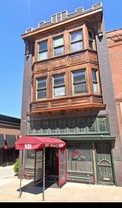James Fitzpatrick Saloon Building; The Majestic
Introduction
Text-to-speech Audio
Now a restaurant called The Majestic, the historic James Fitzpatrick Saloon Building was erected in 1911 and is a contributing property of the Wholesale District, which is listed on the National Register of Historic Places. This historic landmark has been around for 111 years and has been at the epicenter of city growth. The Majestic has seen much of Kansas City's history from the jazz era, Wild West, the first rail crossing of the Missouri River, the birth of Kansas City barbecue, and emergence of the garment industry. The building is in excellent condition and features a two-story projecting bay, and stained glass windows above the entrance.
Images
Built in 1911, the James Fitzpatrick Saloon Building is significant for its association with the emergence of jazz and the garment industry. It is now a restaurant and jazz club called The Majestic Restaurant.

Backstory and Context
Text-to-speech Audio
Wholesale District
The history of the wholesale district dates back to the mid-1850s when Colonel Kersey Coates developed the area into the city's first residential neighborhood. He arrived in 1854 on behalf of Pennsylvania investors who bought the land and instructed him to search for minerals. After Coates found none, they told him to sell the land in parcels. However, Coates bought it and platted it instead, calling it "Quality Hill." He contributed in other ways too, building the first Kansas City Board of Trade Building, as well as the Coates Opera House in 1868 and the Coates Opera Hotel in 1891 at 10th and Broadway Streets. Neither exist today but they helped turn the intersection into one of the city's important cultural hubs.
In the 1870s and early 1880s, Broadway became a thriving commercial avenue while the streets to the west and east remained residential. Beginning in the mid- 1880s however, the residential parts of the area began to make way for commercial buildings. What spurred this change was the construction of the second Kansas City Board of Trade Building beginning in 1886. Other commercial buildings soon followed, including the Swofford Brothers Dry Goods Company building, which was erected in 1898.
This building drew other wholesalers to the area. As a result, the wholesale district was born and continued to grow. Wholesalers in the district manufactured or distributed a variety of products including clothing, dry goods, furniture, hats, and home furnishings. They shipped these products on the many railroads that connected Kansas City to the rest of the country. After World War I, the garment industry began to slowly develop when upper floors of wholesale buildings were used as sewing space. These evolved into full-fledged garment facilities and a number of garment factories were also built. The district became so successful that New York City was the only city that led it in production.
James Fitzpatrick Saloon Building; The Majestic
James Fitzpatrick opened the saloon in 1911 with the support of brothers "Big Jim" and "Boss Tom" Pendergast. The saloon was on the first floor and a brothel on the second and third floors. Fitzpatrick also lived on the third floor. Prohibition forced the saloon to move to the basement in 1920 where it operated successfully away from the eyes of the law thanks to Boss Tom. This period also saw the introduction of jazz in Kansas City and the saloon was a venue where jazz musicians, including notables such as Count Basie and Charlie Parker, performed regularly. Barbecue emerged in the district during this period as well. In 1907, entrepreneur Henry Perry arrived in Kansas City where he began selling smoked meat sandwiches from a cart. He eventually made his way to the district. After he died, his partner sold Perry's cart to his brother, Arthur, whose barbecue became popular in the city. The rise of the garment industry in the district eventually forced the saloon to close and the building was converted for garment manufacturing.
What the status of the Fitzpatrick building was during mid-20th century is unclear but it was not maintained and fell into disrepair. In 1983, two couples bought the building and spent the next two years restoring it. It became home to several restaurants including The Majestic Steakhouse, which opened in 1992. It also operated as a jazz club. The restaurant closed in 2008 but the current restaurant, The Majestic Restaurant, was opened in 2009 and jazz continues to be performed here.
Sources
LaMartina, Jerry. "Downtown Storefront: The Majestic Steakhouse." December 7, 2007. https://www.bizjournals.com/kansascity/stories/2007/12/10/focus7.html
"The Majestic and the History of Downtown Kansas City." The Majestic. Accessed August 31, 2022. https://majestickc.com/about-us/history-of-downtown-kansas-city.
Miszczuk, Edward J. "Wholesale District." National Park Service - National Register of Historic Places Nomination Form. October 25, 1979. https://mostateparks.com/sites/mostateparks/files/Wholesale%20District.pdf.
